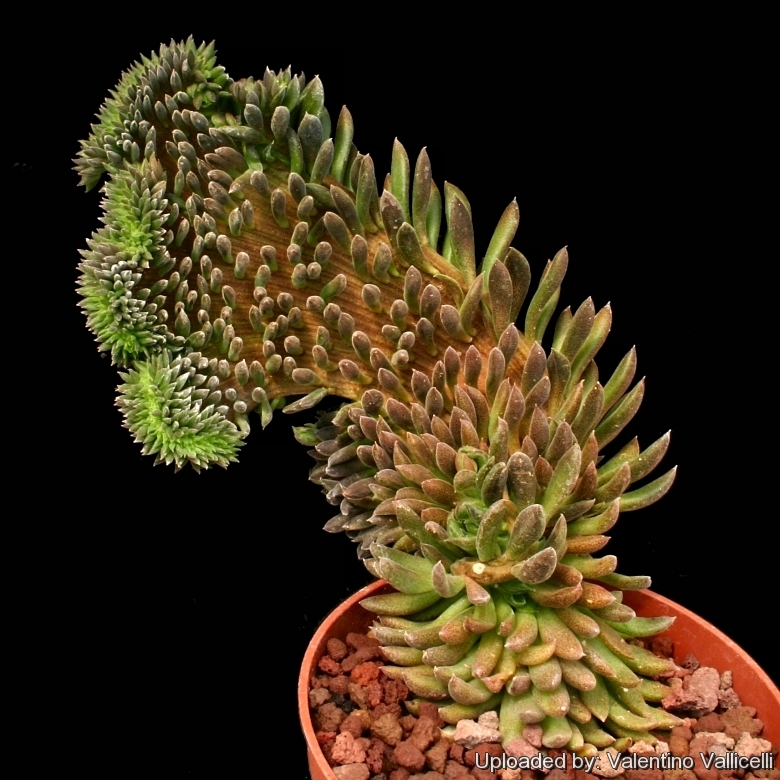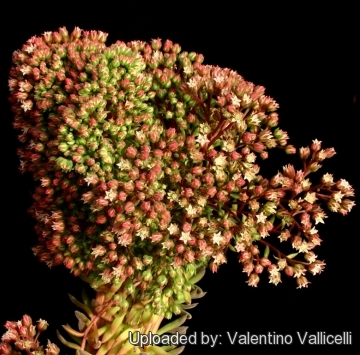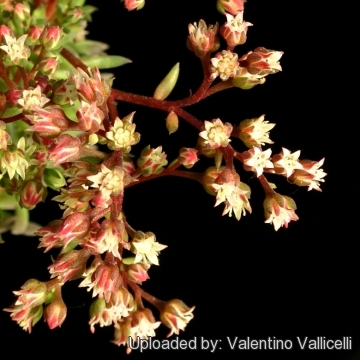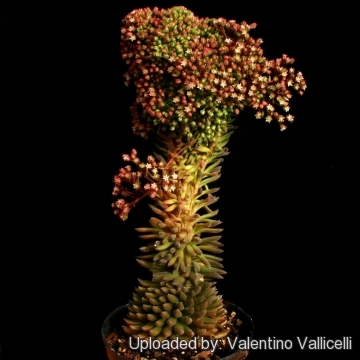Accepted Scientific Name: Sinocrassula yunnanensis (Franch.) A.Berger
Nat. Pflanzenfam., ed. 2 [Engler & Prantl] xviii a. 463 (1930) Engl. & Prantl

Sinocrassula yunnanensis f. cristata Photo by: Valentino Vallicelli
Origin and Habitat: Sinocrassula yunnanensisSN|19295]]SN|19295]] or "Chinese Jade", is native to China’s Yunnan province, north of Burma where it thrives between 2500 and 2700m of altitude. The crested variations is of garden origin (Nursery produced cultivar)
Synonyms:
See all synonyms of Sinocrassula yunnanensis
back
Accepted name in llifle Database:Sinocrassula yunnanensis (Franch.) A.BergerNat. Pflanzenfam., ed. 2 [Engler & Prantl] xviii a. 463 (1930)Synonymy: 6
back
Common Names include:
ENGLISH: Chinese Jade
CHINESE (中文): 云南石莲 yun nan shi lian
Description: It is a small rosette succulent about 5-10 cm tall that can eventually develops into dense clumps and blooms generously.
Rosettes: Upright, closely packed 2.5 to 3.5cm in diameter.
Leaves: Small (1-3cm), fleshy, dark green, flattened, almost terete, acuminate, each with a mucro (soft point) at the tip and patterned with purplish brown speckles and short white hairs.
Flowers: The inflorescence, on a densely leafy deep red peduncle, is a dense, flattish, leafy panicle up to 10-15cm with about 50 minute, whitish flowers with red-tipped oblong-lanceolate petals, 3-4mm long. The flowers scent is of a sweet-sour pungency rather attractive to some but, at any rate, not unpleasant.
Blooming season: Autumn or early winter.
Crested form: The plant shown here is of the type called "cristate", or "fasciated", in which growth is contorted into strange forms. The crested development is sometimes found in all, of the plant although some plants are not very strongly cristate and are partly normal. The fan-like crest can also displays bloom-heads mostly normal in shape.
Subspecies, varieties, forms and cultivars of plants belonging to the Sinocassula yunnanensis group
Bibliography: Major references and further lectures
1) Urs Eggli “Illustrated Handbook of Succulent Plants: Crassulaceae: Crassulaceae” Springer Science & Business Media, 01 January 2003
2) Werner Rauh “The Wonderful World of Succulents: Cultivation and Description of Selected Succulent Plants Other Than Cacti” Smithsonian Institution Press, 1984
3) Clive Innes “Complete Handbook of Cacti and Succulents” Van Nostrand Reinhold Company, 01 December 1981
4) R. Ginns “A guide to cactus and succulent plants” (c/o B. C. F. Hill, 10 Downfield Close, Llandough, Penarth, Glam.)], National Cactus and Succulent Society, 1971
5) Jacobsen. “Handbook of succulent plants” 2: 846, 1960
6) Haage, “Cacti & succulents. a practical handbook.” 77, 1963
7) Jacobsen, “Lexicon of succulent plants”, pl. 133, 1977
8) Lamb & Lamb, “Popular exotic cacti in colour.” 159, 1975
9) James Cullen “The European Garden Flora Flowering Plants: A Manual for the Identification of Plants Cultivated in Europe, Both Out-of-Doors and Under Glass”Cambridge University Press, 11 August 2011
10) “Sinocrassula yunnanensis” in Flora of China @ efloras.org <http://www.efloras.org/florataxon.aspx?flora_id=2&taxon_id=200010037> FOC Vol. 8 Page 214
 The inflorescence is a dense, flattish, leafy panicle up to 10-15cm with 50 to hundreds minute, whitish flowers. Photo by: Valentino Vallicelli
The inflorescence is a dense, flattish, leafy panicle up to 10-15cm with 50 to hundreds minute, whitish flowers. Photo by: Valentino Vallicelli Sinocrassula yunnanensis f. cristata Photo by: Valentino Vallicelli
Sinocrassula yunnanensis f. cristata Photo by: Valentino Vallicelli Sinocrassula yunnanensis f. cristata Photo by: Valentino Vallicelli
Sinocrassula yunnanensis f. cristata Photo by: Valentino Vallicelli Sinocrassula yunnanensis f. cristata Photo by: Valentino Vallicelli
Sinocrassula yunnanensis f. cristata Photo by: Valentino VallicelliCultivation and Propagation: These plants like plenty of light and can tolerate full sun, but don’t worry if the plants aren’t in the sunniest of place; Sinocrassula will also thrive in a less sunny spot and stays relatively small. This species prefers dry conditions and it is best to refrain from watering it until the rootball has dried out completely. The plant can then be immersed in water and well drained and left until it has completely dried out again. Its succulent leaves will store enough water to survive for long time
They can be grown outdoors on rock crevices with favourable water regime, eastern slopes alpine house, poor, drained soil, shading in summer.
Crested growth: Unlike 'monstrose' varieties of plants, where the variation from normal growth is due to genetic mutation, crested growth can occur on normal plants. Sometimes it's due to variances in light intensity, or damage, but generally the causes are unknown. A crested plant may have some areas growing normally, and a cresting plant that looks like a brain, may revert to normal growth for no apparent reason. If you have any of the crested part left you need to remove the normal growth and leave the crested part behind this will need to be done regularly.
Propagation: This is a tough plant which spreads aggressively, both vegetatively by dropped leaves that root easily and by seed. Sow the seeds in winter (13-18°C) uncovered, they will germ in about 1-3 months, division of old plant can be made in spring and late summer; cuttings in summer.
The crested variations can be propagated only by vegetative means, from the crested parts, but seed of such a plant is likely to produce normal progeny.














